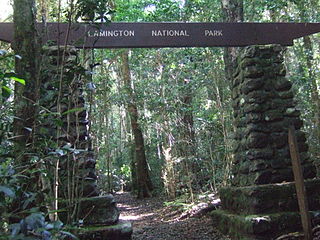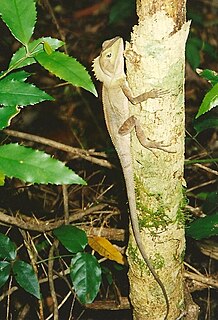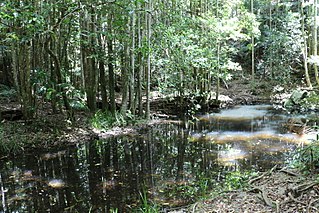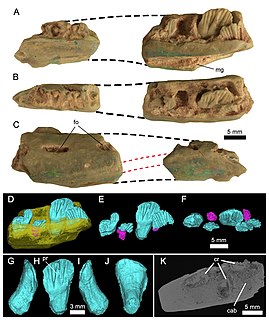
The Brisbane Water National Park is a protected national park that is located in the Central Coast region of New South Wales, in eastern Australia. The 11,506-hectare (28,430-acre) national park is situated 47 kilometres (29 mi) north of Sydney, 10 kilometres (6.2 mi) west of Woy Woy, and 12 kilometres (7.5 mi) southwest of Gosford.
The Morwell National Park is a national park located in the western Gippsland region of Victoria, Australia. The 565-hectare (1,400-acre) national park is situated approximately 164 kilometres (102 mi) east of Melbourne via the Princes Highway and 16 kilometres (9.9 mi) south of Morwell in the Strzelecki Ranges. The park preserves a remnant of previously widespread wet sclerophyll forests and some rainforest remnants restricted to deep creek gullies. 320 plant species have been recorded for this park, including five rare or threatened species and 44 orchid species. 129 native fauna species have been recorded, including 19 mammals, 96 birds, 11 reptiles and three amphibians.

Eungella National Park is a protected area in Queensland, Australia. It is on the Clarke Range at the end of the Pioneer Valley 80 km west of Mackay, and 858 km northwest of Brisbane. Eungella is noted for the national park which surrounds it. It is considered to be the longest continual stretch of sub-tropical rainforest in Australia. The original inhabitants are the Wirri people. The park is covered by dense rainforest and is known for its platypuses.

The Lamington National Park is a national park, lying on the Lamington Plateau of the McPherson Range on the Queensland/New South Wales border in Australia. From Southport on the Gold Coast the park is 85 kilometres (53 mi) to the southwest and Brisbane is 110 kilometres (68 mi) north. The 20,600 hectares Lamington National Park is known for its natural environment, rainforests, birdlife, ancient trees, waterfalls, walking tracks and mountain views. The park protects parts of the Eastern Australian temperate forests.

Ravensbourne is a national park in Ravensbourne and Buaraba in South East Queensland, Australia, 33 km west of Esk. It is a small scenic park on the Great Dividing Range within the Lockyer Creek water catchment area and overlooking the Lockyer Valley. Small remnants of the rainforest and wet eucalypt forest that once covered this part of the Great Dividing Range are preserved in Ravensbourne National Park. Red soils of the park's west and south-west support rainforest that includes eucalypt species as well as palms, vines and ferns. Sandy soils of the park's eastern section support open eucalypt forest. The park is situated in the water catchment areas of the Brisbane River and Lockyer Creek.

The Springbrook National Park is a protected national park that is located in the Gold Coast hinterland of Queensland, Australia. The 6,197-hectare (15,310-acre) park is situated on the McPherson Range, near Springbrook, approximately 100 kilometres (62 mi) south of Brisbane. The park is part of the Shield Volcano Group of the UNESCO World Heritage–listed Gondwana Rainforests of Australia.

Temperate rainforests are coniferous or broadleaf forests that occur in the temperate zone and receive heavy rain.

Kakamega Forest is a tropical rainforest situated in the Kakamega and Nandi County of Kenya, northwest of the capital Nairobi, and near to the border with Uganda. It is Kenya's only tropical rainforest and is said to be Kenya's last remnant of the ancient Guineo-Congolian rainforest that once spanned the continent.
Roberts Creek State Preserve is located in rural Clayton County, Iowa, in Wagner Township, near St. Olaf, Iowa, and a few miles north of Elkader, Iowa. Roberts Creek is a tributary of the Turkey River.
Antrophyum austroqueenslandicum was a species of epiphytic or lithophytic fern known from subtropical rainforest in Lamington National Park in the state of Queensland, Australia. Only one plant was known in the wild and when this plant died the specimen was preserved and used to describe the species. Further searching in nearby habitat has not located any more specimens of this fern.

Aglae is a genus of euglossine bees, with the only described species Aglae caerulea. Like all orchid bees, it is restricted to the Neotropics. They are metallic blue. This species, like the genus Exaerete, is a nest parasite on free-living Euglossini. A. caerulea lays its eggs in the nests of Eulaema nigrita, and possibly other Eulaema species.

Moore Park Nature Reserve is a small remnant of "dry" rainforest in Northern New South Wales. It lies at the confluence of Findon Creek and the Richmond River. It was once part of a larger rainforest known as Boyd's Scrub. A colony of Flying Foxes lives in the rainforest.

The Boorganna Nature Reserve is a protected nature reserve located northwest of Taree on the Comboyne Plateau in New South Wales, Australia. The 396-hectare (980-acre) reserve, managed by the NSW National Parks & Wildlife Service, was gazetted in 1904 and is the second oldest nature reserve in the state. The reserve features various forest types, including stands of sub tropical rainforest of which the large rosewood, yellow carabeen and small leaf fig are particularly noteworthy. The reserve is a remnant of the former extensive rainforest on the Comboyne Plateau. The plateau was cleared between 1900 and 1925. Australian red cedar was logged in the area in the nineteenth century. Originally proposed to be part of the world heritage rainforest group. The exploration, knowledge, uses and history of this area by Indigenous Australians is not well known in the present day. Boorganna Nature Reserve was proposed, but rejected for inclusion on the UNESCO World Heritage, due to being geographically isolated from other rainforests in the group.

Numinbah Nature Reserve is a protected nature reserve that is located in the Northern Rivers region of New South Wales, in eastern Australia. The reserve was gazetted in December 1981 with a further addition made in 1989 to make the reserve to its current area of 858 hectares. The reserve is situated north-east of the rural locality of Numinbah, and south of the Queensland town of Springbrook and defines part of the state border between New South Wales and Queensland.

Blue Creek is a village in the Toledo District of Belize. it is a Mopan people and Kekchi village of about 270 people. The community lies along flat roads, spanning both sides of Blue Creek. Clusters of thatch huts border both sides of Blue Creek, a beautiful, clear stream emerging from the surrounding thick jungle. The colour of blue-green pool where Maya women beat their laundry on the smooth stones gave the village its name. The banks are lined with tall shady trees. The reflection of the thick jungle rainforest, which lines both sides, is clearly visible in the surface of the creek.

Sherwood Nature Reserve is a protected nature reserve located near Woolgoolga in the north coast region of New South Wales, Australia.

Weewarrasaurus is a genus of ornithopod dinosaur from the Late Cretaceous of the Griman Creek Formation near Lightning Ridge, in New South Wales, Australia. The type and only species is W. pobeni, known from the holotype, an isolated dentary preserved in opal, as well as a secondary referred dentary. It is thought to have co-existed with multiple other ornithopods of different sizes and lineages.

Limeburners Creek National Park is a protected national park on the Mid North Coast of New South Wales, Australia. The 91.2 km national park is located 5 km (3.1 mi) to the north of Port Macquarie and exists across both the Kempsey Shire and Port Macquarie-Hastings Council local government areas, but is chiefly managed by National Parks and Wildlife Service. The area was originally erected as a nature reserve but this reservation was revoked when it became formally recognised as a national park in 2010 under the National Parks and Wildlife Act (1974). Many threatened ecological habitats and species of fauna and flora are found within this park, alongside several heritage sites of cultural significance, particularly to the local Birpai and Dunghutti people upon whose land the park exists. The protected status of this national park is largely owing to the ecological and cultural value of the area, in addition to the value of the ecosystems to further scientific research.














